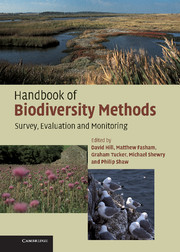Book contents
- Frontmatter
- Contents
- Preface
- Acknowledgements
- Part I Planning
- Part II Habitats
- Part III Species
- 9 Introduction to species assessment
- 10 General principles and methods for species
- 11 Fungi
- 12 Lichens
- 13 Bryophytes
- 14 Aquatic macrophytes and algae
- 15 Vascular plants
- 16 Dragonflies and damselflies
- 17 Butterflies
- 18 Moths
- 19 Other terrestrial invertebrates
- 20 Aquatic invertebrates
- 21 Fish
- 22 Amphibians
- 23 Reptiles
- 24 Birds
- 25 Bats
- 26 Other mammals
- Appendix 1 Monitoring and reporting obligations under international conservation agreements
- Appendix 2 Relationship between BAP Priority Habitat and Broad Habitat categories and Habitats Directive nomenclature
- Appendix 3 Annotated list of key references for plant identification
- Appendix 4 Determining appropriate quadrat size for vegetation sampling
- Appendix 5 The relocation of permanent plots
- Appendix 6 Equipment required for undertaking different types of survey
- Recommended sources of further information
- References
- Glossary
- Index
19 - Other terrestrial invertebrates
Published online by Cambridge University Press: 01 September 2010
- Frontmatter
- Contents
- Preface
- Acknowledgements
- Part I Planning
- Part II Habitats
- Part III Species
- 9 Introduction to species assessment
- 10 General principles and methods for species
- 11 Fungi
- 12 Lichens
- 13 Bryophytes
- 14 Aquatic macrophytes and algae
- 15 Vascular plants
- 16 Dragonflies and damselflies
- 17 Butterflies
- 18 Moths
- 19 Other terrestrial invertebrates
- 20 Aquatic invertebrates
- 21 Fish
- 22 Amphibians
- 23 Reptiles
- 24 Birds
- 25 Bats
- 26 Other mammals
- Appendix 1 Monitoring and reporting obligations under international conservation agreements
- Appendix 2 Relationship between BAP Priority Habitat and Broad Habitat categories and Habitats Directive nomenclature
- Appendix 3 Annotated list of key references for plant identification
- Appendix 4 Determining appropriate quadrat size for vegetation sampling
- Appendix 5 The relocation of permanent plots
- Appendix 6 Equipment required for undertaking different types of survey
- Recommended sources of further information
- References
- Glossary
- Index
Summary
Insects and other arthropods account for 26 000 of the 88 000 species of all groups recorded in Britain. This figure excludes the terrestrial component of the non-arthropod invertebrates such as molluscs (Anon., 1995). These species take a huge variety of forms, occupying many trophic levels and having a variety of either broad or narrow habitat requirements (Strong et al., 1984). Species occupy tree and shrub canopies, grass and herbaceous vegetation, and roam the surface and subterranean components of soil. Species that undergo metamorphosis often have life stages adapted to contrasting habitats or resources within a habitat. Different species can reproduce at different times of the year and in one or more generations a year. There are also temporal considerations important in the design of sampling protocols. The varied life histories of different species translates to varied activity through the season. Different species can also be active during the day, others are active nocturnally, and some are crepuscular. The number of different groups and species in this category is immense. It is therefore not feasible to give specific methods for all groups.
This chapter presents general methods for invertebrate monitoring, which can be adapted to suit the requirements of most groups. However, given the above constraints, as well as the difficulty in identifying many species, there will be many situations in which the only practical course of action will be to engage an appropriate specialist (who may sometimes be a local amateur entomologist) either to design the procedure or to carry out the monitoring work in person.
- Type
- Chapter
- Information
- Handbook of Biodiversity MethodsSurvey, Evaluation and Monitoring, pp. 341 - 358Publisher: Cambridge University PressPrint publication year: 2005



